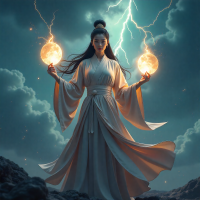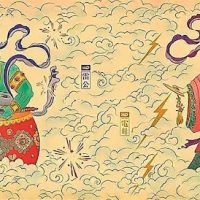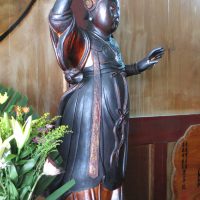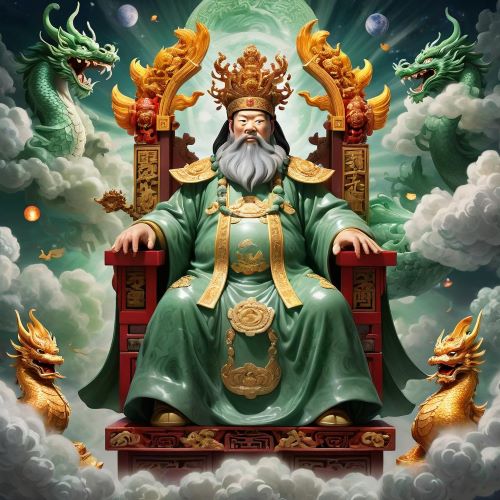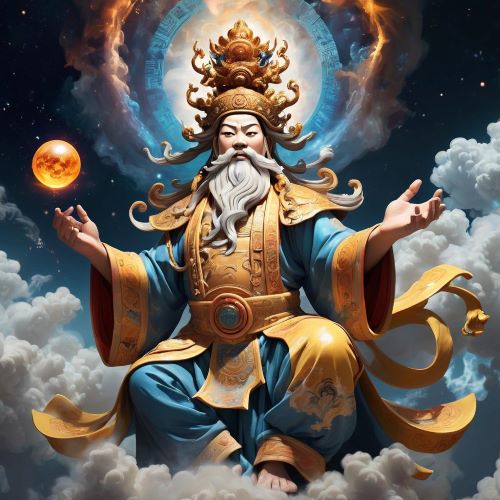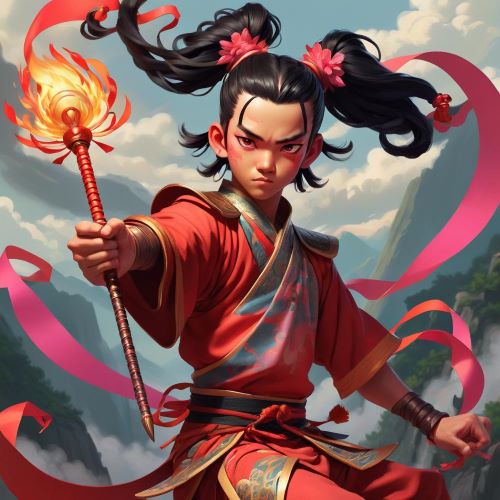Dianmu : The Radiant Chinese Goddess of Lightning
Listen
At a glance
| Description | |
|---|---|
| Origin | Chinese Mythology |
| Classification | Gods |
| Family Members | Lei Gong (Husband) |
| Region | China |
| Associated With | Lightning, Justice |
Dianmu
Introduction
In Chinese mythology, Dianmu (電母)—literally “Mother of Lightning”—stands as one of the most radiant and awe-inspiring celestial deities. Revered for her control over lightning, she is often depicted alongside Leigong (雷公), the god of thunder. Together, they orchestrate the storm’s symphony, with Dianmu’s lightning illuminating the sky before Leigong’s thunder rolls across the heavens. Her myth reflects humanity’s early attempts to understand nature’s forces through divine figures, blending reverence for natural power with deep moral and spiritual meaning. Beyond her mythological role, Dianmu embodies illumination, justice, and the duality of creation and destruction—a balance central to Chinese cosmology.
Physical Traits
Depictions of Dianmu capture her grace and power in equal measure. She is typically portrayed as a beautiful goddess draped in flowing robes, her face serene yet commanding. Her most distinctive symbols are her flashing mirrors, polished to brilliance and capable of summoning lightning with a single reflection. These mirrors symbolize not only her control over light but also her moral clarity—she uses them to illuminate truth and expose wrongdoing. Some artistic representations show her surrounded by glowing clouds or accompanied by phoenixes and dragons, embodying her celestial nature. In temple iconography, Dianmu’s radiant presence often contrasts with Leigong’s fierce appearance, visually reinforcing her role as the light before the thunder.
Family
Dianmu’s most notable familial connection is with Leigong, her divine consort and counterpart in the orchestration of storms. While Leigong wields thunder to punish the wicked, Dianmu ensures his judgment is fair by lighting the skies first—symbolically allowing truth to be seen before justice strikes. This relationship represents the balance between clarity and consequence, a recurring theme in Chinese myth.
In the broader celestial hierarchy, Dianmu is believed to serve under the Jade Emperor, ruler of the heavens, alongside other weather deities such as Yu Shi (Rain Master), Yun Tong (Cloud Youth), and Feng Po Po (Wind Goddess). Together, these deities form the heavenly meteorological court, each responsible for one element of the storm cycle. Their cooperation symbolizes cosmic harmony and the interconnectedness of nature’s elements in Chinese thought.
Other names
Dianmu is known by several alternative titles, each emphasizing different aspects of her divine identity. She is often called Leizi (雷姊) or “Thunder Sister,” a name reflecting her association with thunder and her role within Leigong’s pantheon. Another common title, Leigong zhi qi (雷公之妻), translates as “Wife of Leigong,” acknowledging her position in the thunder god’s celestial household. In some Taoist traditions, she is revered as Tianmu (天母), meaning “Heavenly Mother,” linking her to broader maternal archetypes found throughout Chinese mythology. The epithet Holy Mother of Golden Light highlights her brilliance and sanctity, reinforcing her image as a radiant guardian who commands both reverence and awe.
Powers and Abilities
Dianmu’s powers are closely tied to her role as the divine embodiment of lightning. Her flashing mirrors are her signature tools—by angling them toward the earth, she releases brilliant streaks of light that split the sky. These bolts always precede thunder, reflecting ancient observation of lightning’s precedence over sound. This interplay of light and sound became mythologized as Dianmu’s warning signal to Leigong, ensuring that thunder never strikes without her illumination first.
Beyond her meteorological control, Dianmu’s lightning has moral purpose. In many stories, she uses her light to expose hidden evils, while Leigong’s thunder serves as retribution. This pairing transforms natural phenomena into acts of cosmic justice, reinforcing Confucian ideals of order, morality, and righteous punishment. Dianmu’s lightning thus symbolizes truth, revelation, and divine fairness.
In certain legends, she also possesses the ability to fly and transform into birds or dragons, reinforcing her connection to heaven and her dominion over the skies. In Journey to the West, she briefly appears as part of the divine forces controlling weather and natural elements, emphasizing her enduring presence in Chinese literary tradition.
Modern Day Influence
Though rooted in ancient cosmology, Dianmu’s name and symbolism have endured well into the modern era. In meteorology, several typhoons and tropical storms have been named “Dianmu,” including Typhoon Dianmu in 2004 and Tropical Storm Dianmu in 2021. These meteorological uses pay homage to her mythological command of lightning and storms.
In Chinese folk religion and Taoist temples, she continues to be venerated as a protective goddess. Offerings are made to Dianmu and Leigong to safeguard homes from lightning strikes and to ensure favorable weather for crops. Her worship is particularly noted in southern China and Taiwan, where annual ceremonies honor her as part of broader thunder god festivals.
In modern culture, Dianmu’s image has re-emerged in literature, video games, and digital media, often reinterpreted as a symbol of feminine strength and celestial authority. Artists depict her as a modern storm goddess—graceful yet formidable—embodying the timeless power of light in a world that still fears the storm. Her myth continues to inspire discussions about harmony between nature and justice, making Dianmu a bridge between ancient wisdom and contemporary imagination.
Related Images
Source
Britannica. (2025, April 23). Dian Mu | Chinese mythology. Britannica. https://www.britannica.com/topic/Dian-Mu
Wikipedia contributors. (2024, June 14). Dianmu. Wikipedia. https://en.wikipedia.org/wiki/Dianmu
MythologyChinese.com. (2025, June 30). Dian mu – Chinese Mythology. https://mythologychinese.com/dianmu
Mythopedia. (2022, November 28). Dianmu. Mythopedia.com. https://mythopedia.com/dianmu
Wikipedia contributors. (2002, July 30). Chinese dragon. Wikipedia. https://en.wikipedia.org/wiki/Chinese_dragon
Yang, L., An, D., & Turner, J. (2005). Handbook of Chinese Mythology. Oxford University Press.
Birrell, A. (1993). Chinese Mythology: An Introduction. Johns Hopkins University Press.
Wu, C. (2010). Thunder Gods and Lightning Mothers: Weather Deities in Chinese Folk Religion. Journal of Asian Studies, 69(3), 587–612.
Eberhard, W. (1986). A Dictionary of Chinese Symbols: Hidden Symbols in Chinese Life and Thought. Routledge.
Schafer, E. H. (1963). The Divine Woman: Dragon Ladies and Lightning Mothers in Chinese Myth. Harvard Journal of Asiatic Studies, 23(1), 1–29
Frequently Asked Questions
Who is Dianmu in Chinese mythology?
Dianmu, also known as the Mother of Lightning, is a Chinese goddess who controls lightning and is often depicted as the consort of Leigong, the god of thunder.
What is Dianmu known for?
She is known for using polished mirrors to create lightning flashes that illuminate the sky before thunder, symbolizing truth and divine justice.
Is Dianmu still worshipped today?
Yes. Dianmu is still venerated in Taoist temples and folk traditions across China and Taiwan, often alongside Leigong during weather-related rituals.
What do Dianmu’s mirrors represent?
Her mirrors symbolize illumination, revelation, and the moral clarity that precedes justice—mirroring her role in ensuring thunder strikes only the guilty.
Why are typhoons named after Dianmu?
The name Dianmu is used for typhoons in the Pacific as a tribute to her role as the goddess of lightning, representing nature’s raw yet controlled power.


